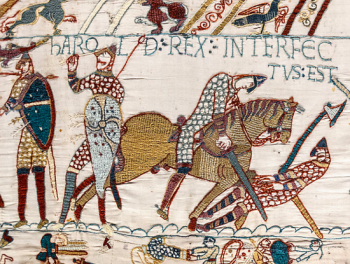11 February 1905
Comic strips are a standard feature in most newspapers. The Ottawa Citizen currently publishes twenty comics daily, ranging from one image stories to four- or five-panel strips. On Saturdays, the Citizen publishes the comics in colour—sticking with a tradition of a weekend colour comic supplement that goes back to the dawn of newspaper cartoons. Most of the comics in the Citizen are written by Americans whose work has been syndicated to other newspapers around the world. The only exceptions are Carpe Diem, written and drawn by Niklas Eriksson of Sweden, and Between Friends by Canadian Sandra Bell-Lundy. Many of the strips have been published for decades. In longest production is Blondie whose run began in 1930. Cartoonist Chic Young wrote and drew the strip until his death in 1973, when his son Dean Young took over.
But comic strips, which can be defined as a telling of a story through a series of pictures, have a far longer and illustrious pedigree. Some historians contend that Trajan’s column in Rome, which tells in sculptured pictures the victory of the Roman emperor over the Dacians (modern-day Romanians) in the second century A.D., is a precursor form of a comic strip. A thousand years later in about 1070, Bishop Odo of Bayeux commissioned the making of another early “comic strip” known today as the Bayeux Tapestry. Made by female needle workers, possibly nuns, in Canterbury, England, the tapestry recounts the story of the Norman conquest of England by William the Conqueror that had occurred four years earlier. Bishop Odo was Duke William’s half-brother and principal supporter. Embroidered on linen cloth using multi-coloured woollen yard, it is roughly 68 metres long and 50 centimetres high, and is composed of 75 picture panels. Complete with Latin text, the tapestry is a marvel of medieval European art.
Following the invention of the printing press, satirists and caricaturists used cartoons to mock the social, political and religious life of their times. William Hogarth (1697-1764), an English painter, painted in 1731 a series of moralizing but humorous paintings that he subsequently had engraved and sold together called A Harlot’s Progress. Highly successful, this series was followed by the famous A Rake’s Progress and Marriage à la Mode. The British caricaturist and illustrator, George Cruikshank (1792-1878) was the author of many satirical and funny cartoons that lampooned the aristocracy, including King George IV and Queen Charlotte. He was one of the first to employ the multi-panel structure and dialogue bubbles used in cartoon strips of today. His 1849 comic strip The Preparatory School for Fast Men starred the likes of Professor Boozey Swizzle who taught drinking class and Professor Swindle in charge of Finance. See George Cruikshank in Lambiek Comiclopedia.
Newspaper cartoon strips begun appearing at the end of the nineteenth century in the United States. They quickly swept North America when newspaper owners realized that comics sold copies. American Richard F. Outcault (1863-1928) is generally regarded as the father of the modern newspaper cartoon strip. He introduced readers of the New York World newspaper, owned by Joseph Pulitzer, to Uncle Eben’s Ignorance of the City in 1894. He also created the character of The Yellow Kid—a street urchin. Wearing a hand-me-down, oversized, yellow shirt, the Kid was likely drawn bald to indicate that his head had been shaved to prevent lice, a constant problem in the crowded urban slums of North America.
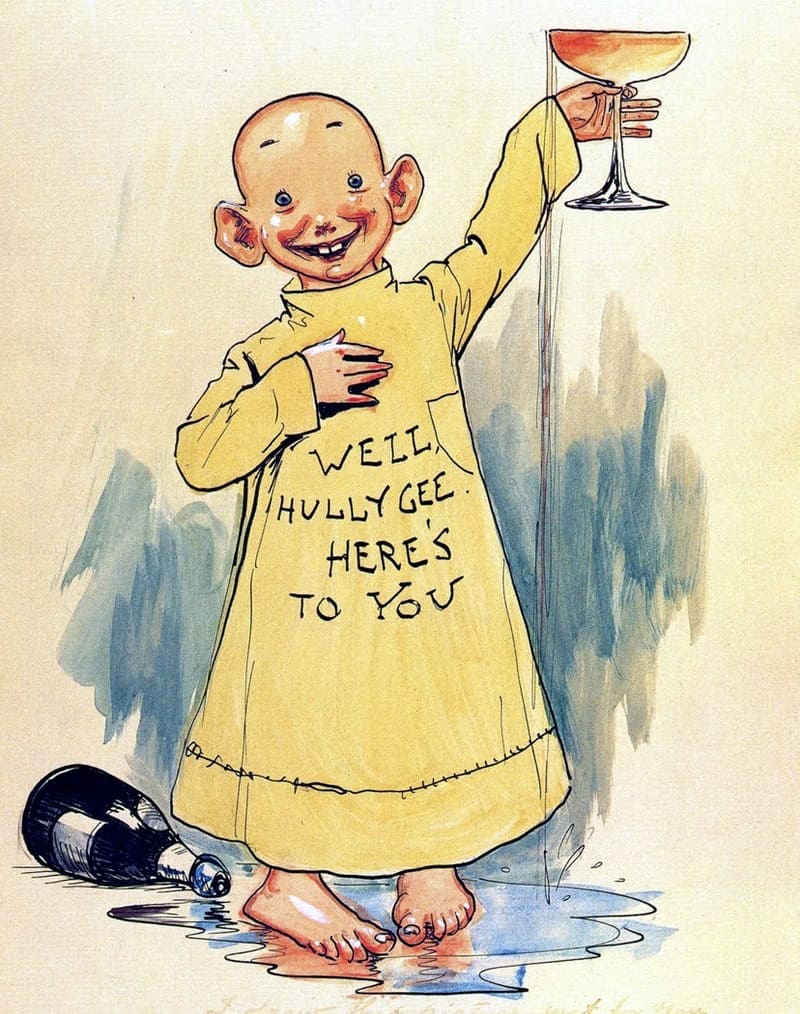 The Yellow Kid by R.F. Outcault, 1896
The Yellow Kid by R.F. Outcault, 1896
WikipediaThe Yellow Kid and his Phonograph, written in 1896, is believed by many to be the first modern comic strip that combined multiple image panels and speech bubbles. When Outcault was lured away from Pulitzer to the New York Journal-American by William Randolph Hearst in 1907, competing versions of The Yellow Kid were produced by the two newspapers as Outcault had failed to obtain a copyright on the character. The less-popular World version was written by George Luks. The expression “yellow journalism” is based on the Pulitzer/Hearst cartoon rivalry. The expression came to mean an emphasis on comics, fictitious news, exaggeration and misleading headlines. In Britain, it is often referred to as “tabloid journalism.”
Canadians were also active in the early days of newspaper cartooning. Henri Julien (1852-1908), who reportedly spent part of his childhood in Ottawa, drew cartoons for Canadian Illustrated News and satirical publications such as Le Canard. He later became the artistic director for the Montreal Daily Star. Palmer Cox (1840-1924) created the Brownies, a very popular series of humorous cartoon stories about sprite-like creatures based on British mythology. Like later twentieth-century cartoon characters, the Brownies were widely merchandized as toys, games, cards, etc. though Palmer apparently didn’t reap the rewards. Even the early Kodak camera, the Brownie, capitalized on their popularity. Another prominent early Canadian cartoonist was Arthur Racey (1870-1941). He drew a series of humorous drawings called The Englishman in Canada in 1893-94 that incorporated speech bubbles. Racey took over Julien’s position at the Montreal Daily Star after the latter’s death.
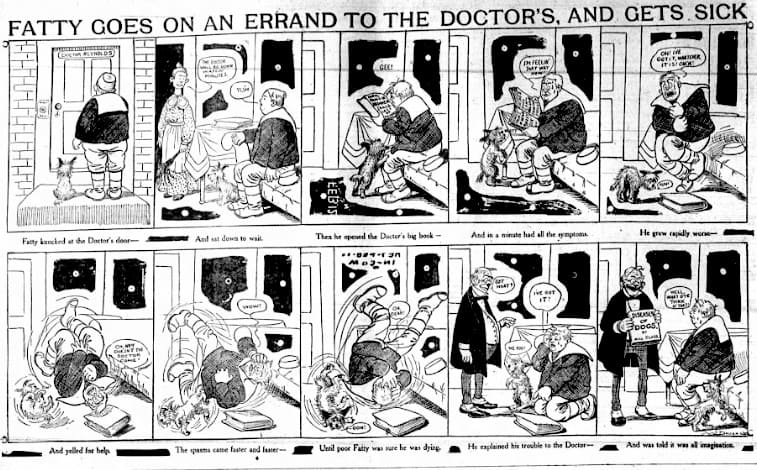 Fatty Felix by Walter McDougall,
Fatty Felix by Walter McDougall,
The Ottawa Evening Journal, 11 February 1905
The weekend funnies came to Ottawa on 11 February 1905 when the Ottawa Evening Journal published without fanfare three multi-pane cartoon strips. The first was called Fatty Goes On An Errand To The Doctor’s And Gets Sick, featuring Fatty Felix, created by the American cartoonist Walt McDougall (1858-1938). McDougall was an illustrator for the New York Graffic, and was published in Harper’s Weekly and Puck Magazine. Reflecting the power of cartoons to effect society, McDougall’s 1884 satirical cartoon The Royal Feast of Belshazzar Blaine and the Money Kings, which appeared in the New York World newspaper, skewered James Blaine, the Republican nominee for President, and is credited with helping Democratic Grover Cleveland win the U.S. Presidency that year. McDougall drew Fatty Felix originally for Philadelphia’s North American. Later, the comic strip also appeared in newspapers associated with the New York Herald’s syndicate. McDougall is also well known for his Handsome Hautry and The Wizard of Oz comic strips.
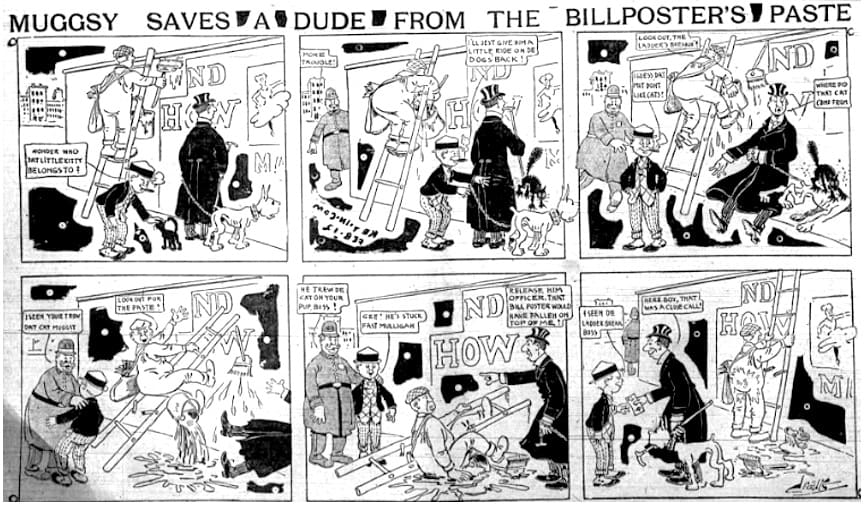 Comic Strip Featuring Muggsy by Frank Crane
Comic Strip Featuring Muggsy by Frank Crane
The Ottawa Evening Journal, 11 February 1905.
The other major cartoon strip in the Journal was called Muggsy Saves A Dude From The Billposter’s Paste drawn by Frank Crane (1857-1917). Crane, who had graduated from the New York Academy of Design, became a cartoonist and later the art editor for the New York World and later for Philadelphia’s North American. Muggsy was also distributed through the New York Herald syndicate. Crane produced the Muggsy comic strip from 1901 to 1915.
 Untitled by unknown cartoonist
Untitled by unknown cartoonist
The Ottawa Evening Journal, 11 February 1905.
Sandwiched between the McDougall and Crane comic strips was a short four-panel strip featuring a circus elephant getting his tooth pulled. There is no title or dialogue, and the author’s name is unclear.
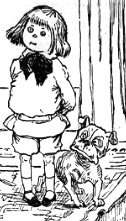 Buster Brown and Tige, by R. Outcault,
Buster Brown and Tige, by R. Outcault,
The Ottawa Evening Citizen, 13 January 1906.The Ottawa Citizen began publishing regular comic strips a year after its rival. From the beginning of January 1906, Richard Outcault’s full-page Buster Brown comic strip, which originally appeared in the New York Herald, could be read in the Citizen. Buster Brown was an upper-class imp with a page-boy haircut who was accompanied by his pit bull terrier Tige. The series was like a cross between Dennis the Menace and Calvin and Hobbes. When Tige spoke only Buster could hear him. Each Buster Brown story ended in a moral with Buster resolving to do something. As was the case with the Yellow Kid, the comic strip got caught up in the Pulitzer/Hearst rivalry with competing versions of the cartoon being produced. Not having the rights to the strip’s title, post-1907 Buster Brown comic strips produced by Outcault were published without a title. Buster Brown became hugely popular across North America. The comic spawned the 1904 silent short movie Buster Brown and the Dude. That same year, Buster Brown’s name was licensed by the Brown Shoe Company. The company also produced “Mary Jane” shoes named after Buster Brown’s comic sweetheart.
In later decades, Ottawa’s two major newspapers carried all of the famous American comic strips, many of whose names remain household words. The Katzenjammer Kids, Bringing Up Father, and Mutt & Jeff were published by the Journal in the 1920s and 1930s. Little Orphan Annie, Popeye, Mickey Mouse and Superman followed in the 1940s. Blondie, with her hapless husband Dagwood Bumstead, debuted in the Journal just a couple of weeks before the start of World War II. Readers of the Citizen would find Felix the Cat, Henry, Li’l Abner, and Tarzan during the 1930s and 1940s, and Roy Rogers Joe Palooka and Dennis the Menace in the 1950s. Beginning in 1957, Citizen readers could also enjoy the philosophy and wisdom of Charlie Brown, Lucy and Linus when the Peanuts comic strip of Charles Schultz first appeared.
So, the next time you pick up the newspaper to read Bizzaro or Hagar The Horrible spare a thought to their rich comic history that stretches back at least two thousand years.
Sources:
America Comes Alive, “Buster Brown Shoes and Mary Janes".
BBC History Magazine, 2018. “5 Bayeux Tapestry facts: what is it, why was it made and what story does it tell?,” History Extra, https://www.historyextra.com/period/norman/5-bayeux-tapestry-facts-what-is-it-why-was-it-made-and-what-story-does-it-tell/.
Haltz, Allan, 2018. Strippers’ Guide.
Lambiek Comiclopedia, 2018, Palmer Cox.
—————————, 2018. Frank Crane.
—————————, 2018. George Cruikshank.
—————————, 2018, Henri Julien.
—————————, 2018. Walt McDougall.
—————————, 2018. Richard H. Outcault.
—————————, 2018, Arthur Racey.
Old Things, 2013. Buster Brown by R.F. Outcault, 31 October.
Ottawa Evening Journal (The), 11 February 1905.
San Francisco Academy of Comic Art Collection, Newspaper Comic Strips Guide.
Saturday Evening Citizen (The), 12 January 1906.
Story written by James Powell, the author of the blog Today in Ottawa's History.
Retired from the Bank of Canada, James is the author or co-author of three books dealing with some aspect of Canadian history. These comprise: A History of the Canadian Dollar, 2005, Bank of Canada, The Bank of Canada of James Elliott Coyne: Challenges, Confrontation and Change,” 2009, Queen’s University Press, and with Jill Moxley, Faking It! A History of Counterfeiting in Canada, 2013, General Store Publishing House, Renfrew, Ontario. James is a Director of The Historical Society of Ottawa.



